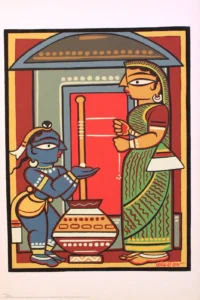Kalighat painting is a traditional style of Indian art that originated in the 19th century around the Kalighat temple in Kolkata (then Calcutta), West Bengal. Initially created as souvenirs for temple visitors, these paintings evolved into a unique artistic form that blended religious themes with contemporary social commentary.

Kalighat paintings are known for:
-
Bold, sweeping brushstrokes
-
Vibrant, flat colors
-
Stylized figures with expressive eyes and gestures
-
Minimal background details
-
Narrative content

A mother’s love divine — Yashoda with Bal Krishna, in bold strokes and timeless devotion.” often based on:
-
Hindu mythology (e.g., gods and goddesses like Kali, Shiva, Krishna)
-
Folk tales
-
Social issues and satire (e.g., hypocrisy of priests, British colonial rule, changing gender roles)
-
This art form was a powerful visual medium that reflected the culture and society of 19th-century Bengal, often commenting on the moral and social contradictions of the time.

🖌 Method of Kalighat Painting:
-
Materials Used:
-
Handmade or mill paper
-
Natural or homemade pigments (from vegetables, stones, charcoal, etc.)
-
Brushes made from squirrel or goat hair
-
Ink (often black) made from soot and water
-
-
Preparation:
-
The paper is burnished with a shell or stone to make it smooth.
-
A base coat (often white or light-colored) is applied for the background.
-
-
Drawing:
-
Artists first sketch the figure lightly in pencil or charcoal.
-
Outlines are then done with bold black ink using a fine brush.
-
-
Coloring:
-
Natural pigments are applied using soft brushes.
-
Colors are flat, with little to no shading, emphasizing bold contrast.
-
-
Finishing Touches:
-
Details like ornaments, eyes, or cloth patterns are added last.
-
No elaborate backgrounds – focus remains on the central figure.
-
